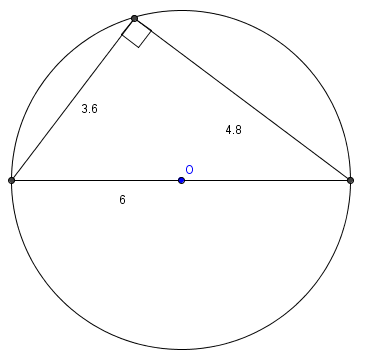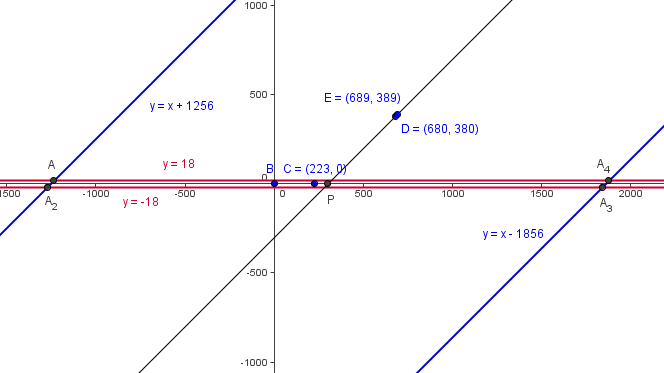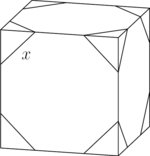- Raybet比分 提供学术活动、国际课程、科研项目一站式留学背景提升服务!
- 400 888 0080
2007 AMC12A 真题及答案详细解析
2007 AMC 12 A 真题
答案详细解析请参考文末
Problem 1
One ticket to a show costs ![]() at full price. Susan buys 4 tickets using a coupon that gives her a 25% discount. Pam buys 5 tickets using a coupon that gives her a 30% discount. How many more dollars does Pam pay than Susan?
at full price. Susan buys 4 tickets using a coupon that gives her a 25% discount. Pam buys 5 tickets using a coupon that gives her a 30% discount. How many more dollars does Pam pay than Susan?
![]()
Problem 2
An aquarium has a rectangular base that measures 100 cm by 40 cm and has a height of 50 cm. It is filled with water to a height of 40 cm. A brick with a rectangular base that measures 40 cm by 20 cm and a height of 10 cm is placed in the aquarium. By how many centimeters does the water rise?
![]()
Problem 3
The larger of two consecutive odd integers is three times the smaller. What is their sum?
![]()
Problem 4
Kate rode her bicycle for 30 minutes at a speed of 16 mph, then walked for 90 minutes at a speed of 4 mph. What was her overall average speed in miles per hour?
![]()
Problem 5
Last year Mr. Jon Q. Public received an inheritance. He paid ![]() in federal taxes on the inheritance, and paid
in federal taxes on the inheritance, and paid ![]() of what he had left in state taxes. He paid a total of
of what he had left in state taxes. He paid a total of ![]() for both taxes. How many dollars was his inheritance?
for both taxes. How many dollars was his inheritance?
![]()
Problem 6
Triangles ![]() and
and ![]() are isosceles with
are isosceles with ![]() and
and ![]() . Point
. Point ![]() is inside triangle
is inside triangle ![]() , angle
, angle ![]() measures 40 degrees, and angle
measures 40 degrees, and angle ![]() measures 140 degrees. What is the degree measure of angle
measures 140 degrees. What is the degree measure of angle ![]() ?
?
![]()
Problem 7
Let ![]() , and
, and ![]() be five consecutive terms in an arithmetic sequence, and suppose that
be five consecutive terms in an arithmetic sequence, and suppose that ![]() . Which of
. Which of ![]() or
or ![]() can be found?
can be found?
![]()
Problem 8
A star-polygon is drawn on a clock face by drawing a chord from each number to the fifth number counted clockwise from that number. That is, chords are drawn from 12 to 5, from 5 to 10, from 10 to 3, and so on, ending back at 12. What is the degree measure of the angle at each vertexin the star polygon?
![]()
Problem 9
Yan is somewhere between his home and the stadium. To get to the stadium he can walk directly to the stadium, or else he can walk home and then ride his bicycle to the stadium. He rides 7 times as fast as he walks, and both choices require the same amount of time. What is the ratioof Yan's distance from his home to his distance from the stadium?
![]()
Problem 10
A triangle with side lengths in the ratio ![]() is inscribed in a circle with radius 3. What is the area of the triangle?
is inscribed in a circle with radius 3. What is the area of the triangle?
![]()
Problem 11
A finite sequence of three-digit integers has the property that the tens and units digits of each term are, respectively, the hundreds and tens digits of the next term, and the tens and units digits of the last term are, respectively, the hundreds and tens digits of the first term. For example, such a sequence might begin with the terms 247, 475, and 756 and end with the term 824. Let ![]() be the sum of all the terms in the sequence. What is the largest prime factor that always divides
be the sum of all the terms in the sequence. What is the largest prime factor that always divides ![]() ?
?
![]()
Problem 12
Integers ![]() and
and ![]() , not necessarily distinct, are chosen independently and at random from 0 to 2007, inclusive. What is the probability that
, not necessarily distinct, are chosen independently and at random from 0 to 2007, inclusive. What is the probability that ![]() is even?
is even?
![]()
Problem 13
A piece of cheese is located at ![]() in a coordinate plane. A mouse is at
in a coordinate plane. A mouse is at ![]() and is running up the line
and is running up the line ![]() . At the point
. At the point ![]() the mouse starts getting farther from the cheese rather than closer to it. What is
the mouse starts getting farther from the cheese rather than closer to it. What is ![]() ?
?
![]()
Problem 14
Let a, b, c, d, and e be distinct integers such that
![]()
Problem 15
The set ![]() is augmented by a fifth element
is augmented by a fifth element ![]() , not equal to any of the other four. The median of the resulting set is equal to its mean. What is the sum of all possible values of
, not equal to any of the other four. The median of the resulting set is equal to its mean. What is the sum of all possible values of ![]() ?
?
![]()
Problem 16
How many three-digit numbers are composed of three distinct digits such that one digit is the average of the other two?
![]()
Problem 17
Suppose that ![]() and
and ![]() . What is
. What is ![]() ?
?
![]()
Problem 18
The polynomial ![]() has real coefficients, and
has real coefficients, and ![]() What is
What is ![]()
![]()
Problem 19
Triangles ![]() and
and ![]() have areas
have areas ![]() and
and ![]() respectively, with
respectively, with ![]()
![]()
![]() and
and ![]() What is the sum of all possible x-coordinates of
What is the sum of all possible x-coordinates of ![]() ?
?
![]()
Problem 20
Corners are sliced off a unit cube so that the six faces each become regular octagons. What is the total volume of the removed tetrahedra?
![]()
Problem 21
The sum of the zeros, the product of the zeros, and the sum of the coefficients of the function ![]() are equal. Their common value must also be which of the following?
are equal. Their common value must also be which of the following?
![]()
![]()
![]()
![]()
Problem 22
For each positive integer ![]() , let
, let ![]() denote the sum of the digits of
denote the sum of the digits of ![]() For how many values of
For how many values of ![]() is
is ![]()
![]()
Problem 23
Square ![]() has area
has area ![]() and
and ![]() is parallel to the x-axis. Vertices
is parallel to the x-axis. Vertices ![]()
![]() , and
, and ![]() are on the graphs of
are on the graphs of ![]()
![]() and
and ![]() respectively. What is
respectively. What is ![]()
![]()
Problem 24
For each integer ![]() , let
, let ![]() be the number of solutions to the equation
be the number of solutions to the equation ![]() on the interval
on the interval ![]() . What is
. What is  ?
?
![]()
![]()
![]()
![]()
![]()
Problem 25
Call a set of integers spacy if it contains no more than one out of any three consecutive integers. How many subsets of ![]() including the empty set, are spacy?
including the empty set, are spacy?
![]()
2007 AMC12 A 真题答案详细解析
 = the amount Pam spent
= the amount Pam spent  = the amount Susan spent
= the amount Susan spent


Pam pays 10 more dollars than Susan
- The brick has volume
 . The base of the aquarium has area
. The base of the aquarium has area  . For every inch the water rises, the volume increases by
. For every inch the water rises, the volume increases by  ; therefore, when the volume increases by
; therefore, when the volume increases by  , the water level rises
, the water level rises 
- Solution 1 Let
 be the smaller term. Then
be the smaller term. Then 
- Thus, the answer is

Solution 2
- By trial and error, 1 and 3 work. 1+3=4.
- Thus, the answer is
![[16 cdot frac{30}{60}+4cdotfrac{90}{60}=14]](https://latex.artofproblemsolving.com/1/0/f/10f984f12d433181bf4e70d5aba17bf45718855a.png)
![[frac{14}2=7Rightarrowboxed{A}]](https://latex.artofproblemsolving.com/e/c/8/ec8d365a6c0eb1087db3b2f36dbfb57ab28a2d4d.png)
- After paying his taxes, he has
 of his earnings left. Since
of his earnings left. Since  is
is  of his income, he got a total of
of his income, he got a total of  .
. - Triangles
 and
and  are isosceles with
are isosceles with  and
and  . Point
. Point  is inside triangle
is inside triangle  , angle
, angle  measures 40 degrees, and angle
measures 40 degrees, and angle  measures 140 degrees. What is the degree measure of angle
measures 140 degrees. What is the degree measure of angle  ?
?
- Let
 be the common difference between the terms.
be the common difference between the terms.
 , so
, so  . But we can't find any more variables, because we don't know what
. But we can't find any more variables, because we don't know what  is. So the answer is
is. So the answer is  .
.  We look at the angle between 12, 5, and 10. It subtends
We look at the angle between 12, 5, and 10. It subtends  of the circle, or
of the circle, or  degrees (or you can see that the arc is
degrees (or you can see that the arc is  of the right angle). Thus, the angle at each vertex is an inscribed angle subtending
of the right angle). Thus, the angle at each vertex is an inscribed angle subtending  degrees, making the answer
degrees, making the answer 
-
Solution 1
Let the distance from Yan's initial position to the stadium be
 and the distance from Yan's initial position to home be
and the distance from Yan's initial position to home be  . We are trying to find
. We are trying to find  , and we have the following identity given by the problem:
, and we have the following identity given by the problem:
Thus
 and the answer is
and the answer is 
Solution 2
Another way of solving this problem is by setting the distance between Yan's home and the stadium, thus filling in one variable. Let us set the distance between the two places to be
 , where
, where  is a random measurement (cause life, why not?) The distance to going to his home then riding his bike, which is
is a random measurement (cause life, why not?) The distance to going to his home then riding his bike, which is  times faster, is equal to him just walking to the stadium. So the equation would be: Let
times faster, is equal to him just walking to the stadium. So the equation would be: Let  the distance from Yan's position to his home. Let
the distance from Yan's position to his home. Let  the distance from Yan's home to the stadium.
the distance from Yan's home to the stadium.



But we're still not done with the question. We know that Yan is
 from his home, and is
from his home, and is  or
or  from the stadium.
from the stadium.  , the
, the  's cancel out, and we are left with
's cancel out, and we are left with  . Thus, the answer is
. Thus, the answer is 
~ProGameXD
Solution 3
Assume that the distance from the home and stadium is 1, and the distance from Yan to home is
 . Also assume that the speed of walking is 1, so the speed of biking is 7. Thus
. Also assume that the speed of walking is 1, so the speed of biking is 7. Thus 
 We need
We need 
 divided by
divided by  =
=
 Since 3-4-5 is a Pythagorean triple, the triangle is a right triangle. Since the hypotenuse is a diameter of the circumcircle, the hypotenuse is
Since 3-4-5 is a Pythagorean triple, the triangle is a right triangle. Since the hypotenuse is a diameter of the circumcircle, the hypotenuse is  . Then the other legs are
. Then the other legs are  and
and  . The area is
. The area is 
- A given digit appears as the hundreds digit, the tens digit, and the units digit of a term the same number of times. Let
 be the sum of the units digits in all the terms. Then
be the sum of the units digits in all the terms. Then  , so
, so  must be divisible by
must be divisible by  . To see that it need not be divisible by any larger prime, the sequence
. To see that it need not be divisible by any larger prime, the sequence  gives
gives  .
. - The only times when
 is even is when
is even is when  and
and  are of the same parity. The chance of
are of the same parity. The chance of  being odd is
being odd is  , so it has a
, so it has a  probability of being even. Therefore, the probability that
probability of being even. Therefore, the probability that  will be even is
will be even is  .
. - We are trying to find the foot of a perpendicular from
 to
to  . Then the slope of the line that passes through the cheese and
. Then the slope of the line that passes through the cheese and  is the negative reciprocal of the slope of the line, or
is the negative reciprocal of the slope of the line, or  . Therefore, the line is
. Therefore, the line is  . The point where
. The point where  and
and  intersect is
intersect is  , and
, and  .
. -
Solution 1
If 45 is expressed as a product of five distinct integer factors, the absolute value of the product of any four it as least
 , so no factor can have an absolute value greater than 5. Thus the factors of the given expression are five of the integers
, so no factor can have an absolute value greater than 5. Thus the factors of the given expression are five of the integers  . The product of all six of these is
. The product of all six of these is  , so the factors are -3, -1, 1, 3, and 5. The corresponding values of a, b, c, d, and e are 9, 7, 5, 3, and 1, and their sum is 25 (C).
, so the factors are -3, -1, 1, 3, and 5. The corresponding values of a, b, c, d, and e are 9, 7, 5, 3, and 1, and their sum is 25 (C).Solution 2
The prime factorization of
 is
is  . Therefore, the 5 distinct integer factors must have some negative numbers in them. Because there are two
. Therefore, the 5 distinct integer factors must have some negative numbers in them. Because there are two  's in the prime factorization, one of them must be negative and the other positive. Because there is a
's in the prime factorization, one of them must be negative and the other positive. Because there is a  , there must also be a
, there must also be a  to cancel the negatives out. The 5 distinct integer factors must be
to cancel the negatives out. The 5 distinct integer factors must be  . The corresponding values of
. The corresponding values of  and
and  are
are  . and their sum is
. and their sum is 
- The median must either be
 or
or  . Casework:
. Casework:
- Median is
 : Then
: Then  and
and  .
.
- Median is
 : Then
: Then  and
and  .
.
- Median is
 : Then
: Then  and
and  .
.
All three cases are valid, so our solution is
 .
. - Median is
-
Solution 1
We can find the number of increasing arithmetic sequences of length 3 possible from 0 to 9, and then find all the possible permutations of these sequences.
Common difference Sequences possible Number of sequences 1 
8 2 
6 3 
4 4 
2 This gives us a total of
 sequences. There are
sequences. There are  to permute these, for a total of
to permute these, for a total of  .
.However, we note that the conditions of the problem require three-digit numbers, and hence our numbers cannot start with zero. There are
 numbers which start with zero, so our answer is
numbers which start with zero, so our answer is  .
.Solution 2
Observe that, if the smallest and largest digit have the same parity, this uniquely determines the middle digit. If the smallest digit is not zero, then any choice of the smallest and largest digit gives
 possible 3-digit numbers; otherwise,
possible 3-digit numbers; otherwise,  possible 3-digit numbers. Hence we can do simple casework on whether 0 is in the number or not.
possible 3-digit numbers. Hence we can do simple casework on whether 0 is in the number or not.Case 1: 0 is not in the number. Then there are
 ways to choose two nonzero digits of the same parity, and each choice generates
ways to choose two nonzero digits of the same parity, and each choice generates  3-digit numbers, giving
3-digit numbers, giving  numbers.
numbers.Case 2: 0 is in the number. Then there are
 ways to choose the largest digit (2, 4, 6, or 8), and each choice generates
ways to choose the largest digit (2, 4, 6, or 8), and each choice generates  3-digit numbers, giving
3-digit numbers, giving  numbers.
numbers.Thus the total is
 .
.Solution 3
This solution takes advantage of the choices available, and as such, will get you nowhere on the AIME and most other contests. Observe that there's a common mistake where people forget that 0 could be part of the number. 4 valid permutations of
 and
and  result in
result in  total that they miss. Looking at the answers, only two differ by
total that they miss. Looking at the answers, only two differ by  , namely
, namely  and
and  . So it's safe to bet that the answer is
. So it's safe to bet that the answer is 
- We can make use the of the trigonometric Pythagorean identities: square both equations and add them up:



This is just the cosine difference identity, which simplifies to

-
Solution 1
A fourth degree polynomial has four roots. Since the coefficients are real(meaning that complex roots come in conjugate pairs), the remaining two roots must be the complex conjugates of the two given roots, namely
 . Now we work backwards for the polynomial:
. Now we work backwards for the polynomial:


Thus our answer is
 .
.Solution 2
Just like in Solution 1 we realize that the roots come in conjugate pairs. Which means the roots are
 So our polynomial is
So our polynomial is(1)

Looking at the equation of the polynomial
 . We see that
. We see that 
If we plug in
 into equation (1) we get
into equation (1) we get  .
.Now if we multiply a complex number by its conjugate we get the sum of the squares of its real and imaginary parts. Using this property on the above we multiply and get
 So the answer is
So the answer is  .
. 
Solution 1
From ![]() , we have that the height of
, we have that the height of ![]() is
is ![]() . Thus
. Thus ![]() lies on the lines
lies on the lines ![]() .
.
![]() using 45-45-90 triangles, so in
using 45-45-90 triangles, so in ![]() we have that
we have that ![]() . The slope of
. The slope of ![]() is
is ![]() , so the equation of the line is
, so the equation of the line is ![]() . The point
. The point ![]() lies on one of two parallel lines that are
lies on one of two parallel lines that are ![]() units away from
units away from ![]() . Now take an arbitrary point on the line
. Now take an arbitrary point on the line ![]() and draw the perpendicular to one of the parallel lines; then draw a line straight down from the same arbitrary point. These form a 45-45-90
and draw the perpendicular to one of the parallel lines; then draw a line straight down from the same arbitrary point. These form a 45-45-90 ![]() , so the straight line down has a length of
, so the straight line down has a length of ![]() . Now we note that the y-intercept of the parallel lines is either
. Now we note that the y-intercept of the parallel lines is either ![]() units above or below the y-intercept of line
units above or below the y-intercept of line ![]() ; hence the equation of the parallel lines is
; hence the equation of the parallel lines is ![]() .
.
We just need to find the intersections of these two lines and sum up the values of the x-coordinates. Substituting the ![]() into
into ![]() , we get
, we get ![]() .
.
Solution 2
We are finding the intersection of two pairs of parallel lines, which will form a parallelogram. The centroid of this parallelogram is just the intersection of ![]() and
and ![]() , which can easily be calculated to be
, which can easily be calculated to be ![]() . Now the sum of the x-coordinates is just
. Now the sum of the x-coordinates is just ![]() .
.
20.
Since the sides of a regular polygon are equal in length, we can call each side ![]() . Examine one edge of the unit cube: each contains two slanted diagonal edges of an octagon and one straight edge. The diagonal edges form
. Examine one edge of the unit cube: each contains two slanted diagonal edges of an octagon and one straight edge. The diagonal edges form ![]() right triangles, making the distance on the edge of the cube
right triangles, making the distance on the edge of the cube ![]() . Thus,
. Thus, ![]() , and
, and  .
.
Each of the cut off corners is a pyramid, whose volume can be calculated by ![]() . Use the base as one of the three congruent isosceles triangles, with the height being one of the edges of the pyramid that sits on the edges of the cube. The height is
. Use the base as one of the three congruent isosceles triangles, with the height being one of the edges of the pyramid that sits on the edges of the cube. The height is ![]() . The base is a
. The base is a ![]() with leg of length
with leg of length ![]() , making its area
, making its area ![]() . Plugging this in, we get that the area of one of the tetrahedra is
. Plugging this in, we get that the area of one of the tetrahedra is  . Since there are 8 removed corners, we get an answer of
. Since there are 8 removed corners, we get an answer of ![]()
21.
By Vieta's formulas, the sum of the roots of a quadratic equation is ![]() , the product of the zeros is
, the product of the zeros is ![]() , and the sum of the coefficients is
, and the sum of the coefficients is ![]() . Setting equal the first two tells us that
. Setting equal the first two tells us that ![]() . Thus,
. Thus, ![]() , so the common value is also equal to the coefficient of
, so the common value is also equal to the coefficient of ![]() .
.
To disprove the others, note that:
 : then
: then  , which is not necessarily true.
, which is not necessarily true. : the y-intercept is
: the y-intercept is  , so
, so  , not necessarily true.
, not necessarily true. : an x-intercept of the graph is a root of the polynomial, but this excludes the other root.
: an x-intercept of the graph is a root of the polynomial, but this excludes the other root. : the mean of the x-intercepts will be the sum of the roots of the quadratic divided by 2.
: the mean of the x-intercepts will be the sum of the roots of the quadratic divided by 2.
22.
Solution 1
For the sake of notation let ![]() . Obviously
. Obviously ![]() . Then the maximum value of
. Then the maximum value of ![]() is when
is when ![]() , and the sum becomes
, and the sum becomes ![]() . So the minimum bound is
. So the minimum bound is ![]() . We do casework upon the tens digit:
. We do casework upon the tens digit:
Case 1: ![]() . Easy to directly disprove.
. Easy to directly disprove.
Case 2: ![]() .
. ![]() , and
, and ![]() if
if ![]() and
and ![]() otherwise.
otherwise.
- Subcase a:
 . This exceeds our bounds, so no solution here.
. This exceeds our bounds, so no solution here. - Subcase b:
 . First solution.
. First solution.
Case 3: ![]() .
. ![]() , and
, and ![]() if
if ![]() and
and ![]() otherwise.
otherwise.
- Subcase a:
 . Second solution.
. Second solution. - Subcase b:
 . Third solution.
. Third solution.
Case 4: ![]() . But
. But ![]() , and
, and ![]() clearly sum to
clearly sum to ![]() .
.
Case 5: ![]() . So
. So ![]() and
and ![]() (recall that
(recall that ![]() ), and
), and ![]() . Fourth solution.
. Fourth solution.
In total we have ![]() solutions, which are
solutions, which are ![]() and
and ![]() .
.
Solution 2
Clearly, ![]() . We can break this into three cases:
. We can break this into three cases:
Case 1: ![]()
- Inspection gives
 .
.
Case 2: ![]() ,
, ![]() (not to be confused with
(not to be confused with ![]() ),
), ![]()
- If you set up an equation, it reduces to
![]()
- which has as its only solution satisfying the constraints
 ,
,  .
.
Case 3: ![]() ,
, ![]() ,
, ![]()
- This reduces to
 . The only two solutions satisfying the constraints for this equation are
. The only two solutions satisfying the constraints for this equation are  ,
,  and
and  ,
,  .
.
The solutions are thus ![]() and the answer is
and the answer is ![]() .
.
Solution 3
As in Solution 1, we note that ![]() and
and ![]() .
.
Obviously, ![]() .
.
As ![]() , this means that
, this means that ![]() , or equivalently that
, or equivalently that ![]() .
.
Thus ![]() . For each possible
. For each possible ![]() we get three possible
we get three possible ![]() .
.
(E. g., if ![]() , then
, then ![]() is a number such that
is a number such that ![]() and
and ![]() , therefore
, therefore ![]() .)
.)
For each of these nine possibilities we compute ![]() as
as ![]() and check whether
and check whether ![]() .
.
We'll find out that out of the 9 cases, in 4 the value ![]() has the correct sum of digits.
has the correct sum of digits.
This happens for ![]() .
.
Solution 4
- This solution is not a good solution, but is viable for in contest situations
Clearly ![]() . Thus,
. Thus,![]() Now we need a bound for
Now we need a bound for ![]() . It is clear that the maximum for
. It is clear that the maximum for ![]() (from
(from ![]() ) which means the maximum for
) which means the maximum for ![]() is
is ![]() . This means that
. This means that ![]() .
.
- Warning: This is where you will cringe badly
Now check all multiples of ![]() from
from ![]() to
to ![]() and we find that only
and we find that only ![]() work, so our answer is
work, so our answer is ![]() .
.
Remark: this may seem time consuming, but in reality, calculating ![]() for
for ![]() values is actually very quick, so this solution would only take approximately 3-5 minutes, helpful in a contest.
values is actually very quick, so this solution would only take approximately 3-5 minutes, helpful in a contest.
23.
Let ![]() be the x-coordinate of
be the x-coordinate of ![]() and
and ![]() , and
, and ![]() be the x-coordinate of
be the x-coordinate of ![]() and
and ![]() be the y-coordinate of
be the y-coordinate of ![]() and
and ![]() . Then
. Then ![]() and
and ![]() . Since the distance between
. Since the distance between ![]() and
and ![]() is
is ![]() , we have
, we have ![]() , yielding
, yielding ![]() .
.
However, we can discard the negative root (all three logarithmic equations are underneath the line ![]() and above
and above ![]() when
when ![]() is negative, hence we can't squeeze in a square of side 6). Thus
is negative, hence we can't squeeze in a square of side 6). Thus ![]() .
.
Substituting back, ![]() , so
, so ![]() .
.
24.
Solution 1
![]()
By looking at various graphs, we obtain that, for most of the graphs
![]()
Notice that the solutions are basically reflections across ![]() . However, when
. However, when ![]() , the middle apex of the sine curve touches the sine curve at the top only one time (instead of two reflected points), so we get here
, the middle apex of the sine curve touches the sine curve at the top only one time (instead of two reflected points), so we get here ![]() .
.
![]()
![]()
![]()
![]()
Solution 2
![]() So
So ![]() if and only if
if and only if ![]() or
or ![]() .
.
The first occurs whenever ![]() , or
, or ![]() for some nonnegative integer
for some nonnegative integer ![]() . Since
. Since ![]() ,
, ![]() . So there are
. So there are ![]() solutions in this case.
solutions in this case.
The second occurs whenever ![]() , or
, or ![]() for some nonnegative integer
for some nonnegative integer ![]() . Here
. Here ![]() so that there are
so that there are ![]() solutions here.
solutions here.
However, we overcount intersections. These occur whenever![]()
![]() which is equivalent to
which is equivalent to ![]() dividing
dividing ![]() . If
. If ![]() is even, then
is even, then ![]() is odd, so this never happens. If
is odd, so this never happens. If ![]() , then there won't be intersections either, since a multiple of 8 can't divide a number which is not even a multiple of 4.
, then there won't be intersections either, since a multiple of 8 can't divide a number which is not even a multiple of 4.
This leaves ![]() . In this case, the divisibility becomes
. In this case, the divisibility becomes ![]() dividing
dividing ![]() . Since
. Since ![]() and
and ![]() are relatively prime (subtracting twice the second number from the first gives 1),
are relatively prime (subtracting twice the second number from the first gives 1), ![]() must divide
must divide ![]() . Since
. Since ![]() ,
, ![]() . Then there is only one intersection, namely when
. Then there is only one intersection, namely when ![]() .
.
Therefore we find ![]() is equal to
is equal to ![]() , unless
, unless ![]() , in which case it is one less, or
, in which case it is one less, or ![]() . The problem may then be finished as in Solution 1.
. The problem may then be finished as in Solution 1.
25.
Solution 1
Let ![]() denote the number of spacy subsets of
denote the number of spacy subsets of ![]() . We have
. We have ![]() .
.
The spacy subsets of ![]() can be divided into two groups:
can be divided into two groups:
 those not containing
those not containing  . Clearly
. Clearly  .
. those containing
those containing  . We have
. We have  , since removing
, since removing  from any set in
from any set in  produces a spacy set with all elements at most equal to
produces a spacy set with all elements at most equal to  and each such spacy set can be constructed from exactly one spacy set in
and each such spacy set can be constructed from exactly one spacy set in  .
.
Hence,
From this recursion, we find that
| 1 | 2 | 3 | 4 | 6 | 9 | 13 | 19 | 28 | 41 | 60 | 88 | 129 |
And so the answer is ![]() ,
, ![]() .
.
Solution 2
Since each of the elements of the subsets must be spaced at least two apart, a divider counting argument can be used.
From the set ![]() we choose at most four numbers. Let those numbers be represented by balls. Between each of the balls there are at least two dividers. So for example, o | | o | | o | | o | | represents
we choose at most four numbers. Let those numbers be represented by balls. Between each of the balls there are at least two dividers. So for example, o | | o | | o | | o | | represents ![]() .
.
For subsets of size ![]() there must be
there must be ![]() dividers between the balls, leaving
dividers between the balls, leaving ![]() dividers to be be placed in
dividers to be be placed in ![]() spots between the balls. The number of way this can be done is
spots between the balls. The number of way this can be done is  .
.
Therefore, the number of spacy subsets is  .
.
Solution 3
A shifting argument is also possible, and is similar in spirit to Solution 2. Clearly we can have at most ![]() elements. Given any arrangment, we subract
elements. Given any arrangment, we subract ![]() from the
from the ![]() element in our subset, when the elements are arranged in increasing order. This creates a bijection with the number of size
element in our subset, when the elements are arranged in increasing order. This creates a bijection with the number of size ![]() subsets of the set of the first
subsets of the set of the first ![]() positive integers. For instance, the arrangment o | | o | | o | | | o | corresponds to the arrangment o o o | o |. Notice that there is no longer any restriction on consectutive numbers. Therefore, we can easily plug in the possible integers 0, 1, 2, 3, 4, 5 for
positive integers. For instance, the arrangment o | | o | | o | | | o | corresponds to the arrangment o o o | o |. Notice that there is no longer any restriction on consectutive numbers. Therefore, we can easily plug in the possible integers 0, 1, 2, 3, 4, 5 for ![]() :
: 
In general, the number of subsets of a set with ![]() elements and with no
elements and with no ![]() consecutive numbers is
consecutive numbers is  .
.
以上解析方式仅供参考
学术活动报名扫码了解!免费领取历年真题!
在线登记
最新发布
Raybet比分 课程体验,退费流程快速投诉邮箱: yuxi@linstitute.net 沪ICP备2023009024号-1











